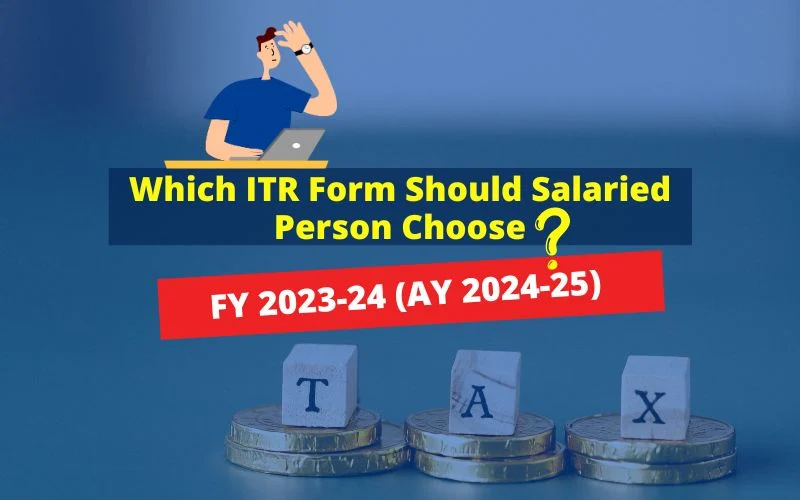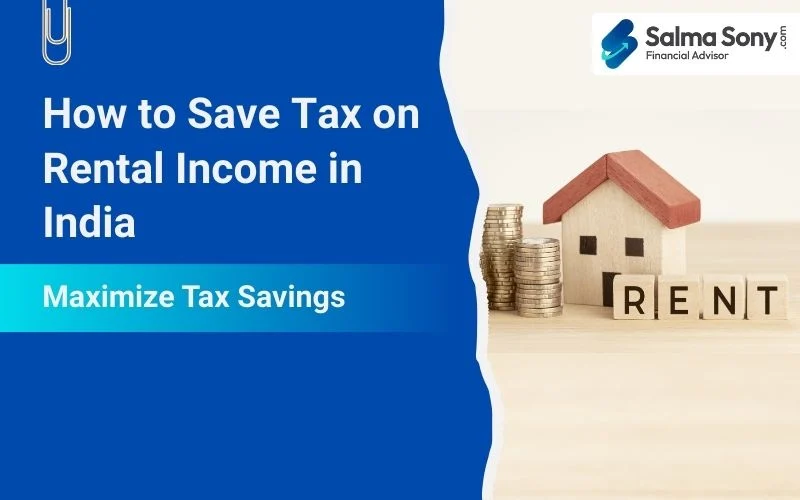ITR for salaried person in India, the applicable Income Tax Return (ITR) form depends on various factors such as income sources, income level, and specific circumstances. In this article, I will explain the different ITR forms that apply to salaried persons.

What is ITR?
ITR stands for Income Tax Return. ITR is the formal document that taxpayers use to report their income, investment, and tax liabilities to the tax authorities, ensuring compliance with tax laws and fulfilling their tax obligations.
ITR for Salaried Person: Is ITR Filing Mandatory?
Yes, ITR filing is mandatory for salaried individuals under the following conditions:
- If a salaried individual’s total income in the year is more than the basic exemption limit.
| Age | Old Regime Basic Exemption Limit | New Regime Basic Exemption Limit |
|---|---|---|
| Below 60 years | Rs. 2 lakhs | Rs. 3 lakhs |
| 60 years or more but below 80 years | Rs. 3 lakhs | Rs. 3 lakhs |
| 80 years or more | Rs 5. lakhs | Rs. 3 lakhs |
- If salaried individuals want to claim an income tax refund.
- If salaried individuals wish to apply for a loan or visa.
- If a salaried individual has earned from foreign assets or invested in a foreign asset during the financial year.
- If salaried individuals have a loss under the capital gains head, they will only be allowed to carry them forward to the next years if they file the ITR before the due date.
- If a salaried individual has deposited a total of Rs 1 cr. or more in one or multiple current accounts with a bank. However, no such restriction on deposits made in post office current accounts.
- If a salaried individual has deposited more than Rs 50 lakh in their ‘savings’ bank accounts.
- If a salaried individual has spent more than Rs 2 lakh on foreign travel, whether for yourself or any other person
- If a salaried individual’s yearly electricity expenditure is more than Rs 1 lakh
- If a salaried individual’s tax is held in the form of TDS is more than Rs 25,000. For a senior citizen (above 60 years), this limit is Rs 50,000.
ITR for Salaried Person: Which ITR to file?
The IT department has notified seven forms, i.e., ITR-1, ITR-2, ITR-3, ITR-4, ITR-5, ITR-6 & ITR-7. I will talk about ITR-1, ITR-2, ITR-3, and ITR-4, as only these forms apply to salaried persons.
1. ITR-1 (Sahaj)
ITR-1, also known as Sahaj, applies to resident individuals in India who have income from salary, single house property, other sources (who do not have income from business or profession), and Agricultural Income up to ₹ 5,000. This form is designed for individuals with income from one or a combination of the four above sources. It is the simplest ITR form available. The total income of the individual should not exceed Rs—50 lakh.
The following individuals can use ITR-1:
- Salaried individuals with income from a single employer.
- Individuals with income from house property (excluding cases where losses are brought forward from previous years).
- Individuals with income from other sources such as interest, pension, or family pensions.
Who cannot file ITR-1?
- Individual’s total income exceeds Rs.50 lakh.
- Individuals have income from more than one house property.
- Individuals have any capital gains (short-term or long-term) or have invested in an unlisted company’s equity shares.
- Individual has any foreign assets or income from a source outside India.
- Individual has brought forward losses from previous years.
- Individual who is a Director in a company.
2. ITR-2
ITR-2 applies to individuals and HUFs (Hindu Undivided Families) not have income from business or profession. It includes income from salary, more than one house property, capital gains, and other sources. The total income can exceed Rs—50 lakhs.
The following individuals can use ITR-2:
- Salaried individuals have income from multiple employers. This situation arises when you change your job in a financial year and need to consider two Form-16 when filing ITR.
- Individuals with income from more than one house property.
- Individuals with capital gains from selling assets like property, stocks, or mutual funds.
- Individuals with income from other sources like interest, pension, or family pension.
- Individuals with agricultural income of more than Rs 5,000
- Individuals whose payment or deduction of tax has been deferred on ESOP
- Individuals who are not eligible to use ITR-1 due to exceeding the income limit or having capital gains, foreign assets, or directorship in a company.
3. ITR-3
ITR-3 applies to individuals and HUFs having income from business or profession. This form is specifically for individuals with income from a proprietary business or profession. It also includes income from salary, house property, capital gains, and other sources. If you have income from salary & proprietary business/ profession, then ITR-3 is to be used.
The following individuals can use ITR-3:
- Individuals with income from a proprietary business or profession.
- Individual’s income as a partner in the firm.
- Professionals such as doctors, lawyers, or consultants have their practice.
- Individuals who are engaged in freelancing or any other form of self-employment.
4. ITR-4 (Sugam)
ITR-4, also known as Sugam, applies to individuals, HUFs, and firms (other than LLP) with income from a presumptive business. It includes income from salary, house property, and other sources. The total income should not exceed Rs. 50 lahks.
The following individuals can use ITR-4:
- Salaried individuals, HUFs, and partnership firms have income from a presumptive business.
- Individuals who have opted for the presumptive taxation scheme under Section 44AD, 44ADA, or 44AE of the Income Tax Act.
The presumptive taxation scheme allows eligible individuals to calculate their taxable income based on a presumptive percentage of their total turnover or gross receipts, thus simplifying the tax calculation process.
Who cannot use ITR-4?
- Individuals whose total income exceeds Rs 50 lakh
- Individuals having unlisted equity shares held at any time during the previous year
- Individuals owning any foreign asset
- Individuals having foreign income
- Individuals whose payment or deduction of tax has been deferred on ESOP
- Individuals have brought forward loss or loss to be carried forward under any head of income.
- An individual who is a director in a company
In addition to the ITR forms mentioned above, other specialized forms are available for specific situations.
For example,
ITR-5 is applicable for firms, LLPs (Limited Liability Partnerships), Association of Persons (AOPs), and Body of Individuals (BOIs).
ITR-6 is for companies that are not claiming exemption under Section 11 (Income from property held for charitable or religious purposes).
ITR-7 is for persons, including companies, who are required to furnish a return under Sections 139(4A) or 139(4B) or 139(4C) or 139(4D) or 139(4E) or section 139(4F) of the Income Tax Act.
It’s important to note that tax laws and forms can be subject to change. Therefore, it is recommended to refer to the official website of the IT Department of India or consult a tax professional for the most up-to-date information and guidance regarding the appropriate ITR form for your specific situation.
📖Must Read: Income Tax New Regime Or Old Regime: For Salaried Employees – Which One Should They Choose?
What Happens If ITR Is Not Filed?
- Penalty: If you do not file your ITR on time, you may be liable to pay penalties and interest. You may have to pay a late filing fine of Rs 5,000. This fine will be reduced to Rs 1,000 if your income is below Rs. 5 lakhs.
- Interest: You may have to pay interest at 1% per month or pro-rata on the unpaid tax amount under Section 234A.
| Penalty Type | Penalty Under Section | Maximum Penalty |
| Late Fee | 234F | Income below 5 Lakhs: Rs.1,000 Income above 5 Lakhs: 🔹Filing After 31st July until 31st Dec: Rs. 5,000 🔹Filing After 31st Dec until 31st March: Rs. 10,000 |
| Interest | 234A | Interest at a rate of 1% per month |
- Loss of Refunds: Filing an ITR allows you to claim any excess tax paid as a refund. If you file your ITR, you will retain the opportunity to receive any refunds owed to you.
- Impact on Visa: If you plan to travel abroad or apply for a visa in certain countries, not having a filed ITR may affect your visa application process. Some countries may require ITR filings as proof of financial stability and income.
💡Must Explore: How financial planning can help you, from budgeting to investing, for a peaceful financial life?
Income tax filing due dates for FY 2023-24 (AY 2024-25)
| Category of Taxpayer | Due Date for Tax Filing- FY 2023-24 (unless extended) |
|---|---|
| Individual / HUF/ AOP/ BOI (books of accounts not required to be audited) | 31st July 2024 |
| Businesses (Requiring Audit) | 31st Oct 2024 |
Avoid 5 Common Tax Filing Mistakes for FY 2023-24 (AY 2024-25)
Mistake-1: Choosing the wrong ITR form
Today’s article is my attempt to help you educate yourself about ITR forms so you do not make mistakes when choosing between ITR 1, ITR 2, ITR 3, and ITR 4. After reading today’s article carefully, I’m sure you will be confident in your choice of ITR form.
Mistake-2: Incorrect personal information
One of the most common mistakes is providing incorrect personal information such as contact number, email ID, address, and bank details. It’s crucial to double-check all personal information before submitting the ITR to avoid any discrepancies.
Mistake-3: Not Reporting Income from Multiple Employers in ITR
If you have changed jobs during the financial year, you must report income from all employers. Ideally, the previous employer must also share Form 16 for the months you served them. Often, individuals forget to report income from previous employers; not reporting income from any job may lead to discrepancies between the Tax Deducted at Source (TDS) certificate and Form 26AS.
Mistake-4: Neglecting Tax-Exempt Income
According to income tax regulations, it’s mandatory to disclose all types of income, including those tax-exempt, if the individual’s total gross income surpasses the basic exemption threshold of Rs. 2.5 lakh in the old tax regime or Rs. 3 lakhs in the new tax regime.
Mistake-5: Not reporting capital gains on switching units of mutual funds
When you redeem, switch, or set STP to move units automatically from one scheme to another mutual fund, they are considered a sale of units, and capital gain or loss arises by taking these actions.
These transactions are captured in each AMC’s Capital gain report and are not reflected in the bank statements as money does not hit the bank account but moves from one fund to another. You can also acquire the capital gain statement from the CAMS & Karvy portal.
If you have worked with a financial planning expert who has planned your investment, lumpsum investments are likely planned with STP and switches. Reporting these in the Income Tax Return is advisable to avoid this common mistake.
Conclusion
It is recommended that you focus on tax planning at the beginning of the financial year rather than the end of the financial year. An excellent way to do this is to focus on financial planning, which also includes tax planning. This will help you achieve your financial goals on time and live a peaceful financial life.





